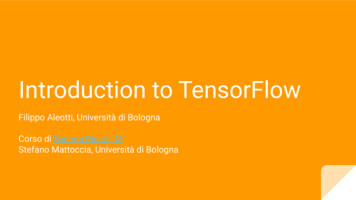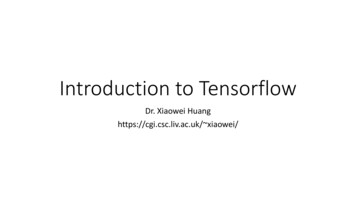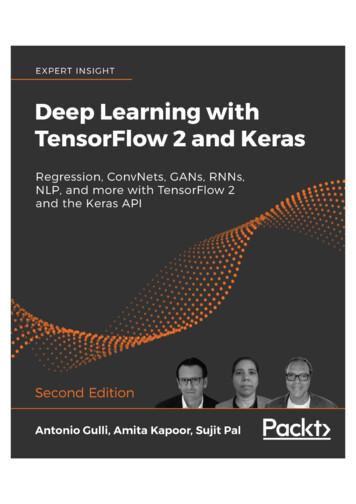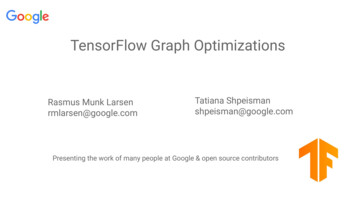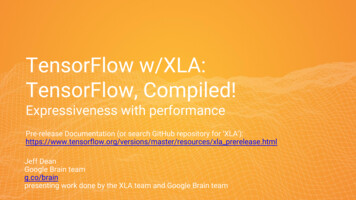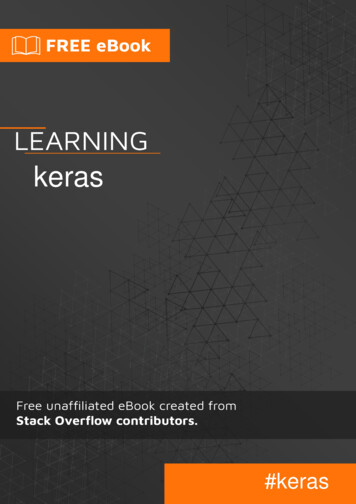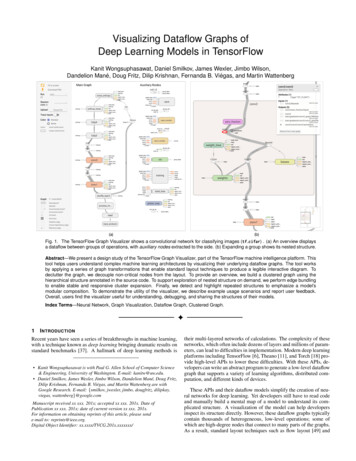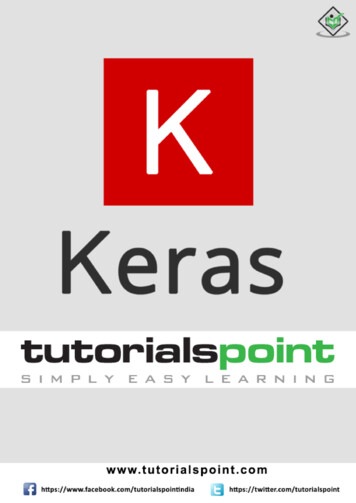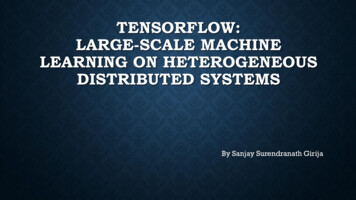
Transcription
TENSORFLOW:LARGE-SCALE MACHINELEARNING ON HETEROGENEOUSDISTRIBUTED SYSTEMSBy Sanjay Surendranath Girija
WHAT IS TENSORFLOW ? “TensorFlow is an interface for expressing machine learningalgorithms, and an implementation for executing such algorithms” Dataflow-like model for computation Supported on a variety of hardware platforms – mobile, pcs, specialized distributedmachines with hundreds of gpus Python and C Front Ends Open Source (www.tensorflow.org )
HISTORY OF TENSORFLOWDistBeliefTensorFlow 2011 First generation scalabledistributed training andinference system Machine Learning systembuilt for deep neuralnetworks 2015 2nd generation system forimplementation anddeployment of largescalemachine learning models More flexibleprogramming model Better performance
APPLICATIONSUsed for both research and production Google Search - RankBrain Google Photos Speech Recognition Google Translate Inception Image Classification Gmail Inbox – SmartReply DeepMind
PROGRAMMING MODEL Dataflow like model Directed Graph with a set of Nodes Each node has zero or more inputs andoutputs Control Dependencies – To enforcehappens-before relationships andorderings Support for control flow operations, loops,conditions
TENSORS n-dimensional array or list Only tensors may be passed between nodes in the computation graph.
OPERATION Node in a TensorFlow Graph that performs computation on tensors Takes zero or more Tensor objects as input, and produces zero or more Tensor objects asoutput. Polymorphic - Same Operation can be used for int32, float) Kernel - Particular implementation of an Operation that can be run on a particular type ofdevice Eg :tf.size(), tf.reshape(), tf.concat(concat dim, values, name 'concat‘),tf.matmul(), tf.matrix inverse(input, adjoint None, name None)tf.Graph.create op()tf.nn.softmax(), tf.sigmoid()tf.train.Saver.save(), tf.train.Saver.restore(sess, save path)
SESSIONS Session : Object that encapsulates theenvironment in which Operation objects areexecuted, and Tensor objects are evaluated. Provides an interface to communicate withMaster and Worker processes tf.Session() Creating session object and closing asession Master Provides instructions to worker processes Using the context manager Worker : Arbitrates access to computationaldevices Executing graph nodes on the workernodes Session with arguments
VARIABLES AND RUN Variable - Operation that returns a handleto a persistent mutable tensor thatsurvives across executions of a graph Run : Runs one "step" of TensorFlowcomputation, by running the necessarygraph fragment to execute everyOperation and evaluate every Tensor infetches Takes a set of output names that need tobe computed, set of tensors to be fed intothe graph in place of certain outputs ofnodes
INSTALLATION AND ENVIRONMENT SETUP https://www.tensorflow.org/versions/r0.10/get started/os setup.html
EXAMPLE - MNIST Handwritten digit recognition using Neural Network Uses Multinomial Logistic Regression (Softmax) 28 by 28 pixel MNIST image Input to the graph – Flattened 2d tensor of floating point numbers of dimensionality784 each (28 * 28) Output - One-hot 10-dimensional vector indicating which digit the correspondingMNIST image belongs to
SUMMARIES Operation which serializes and stores tensor as strings. Summaries can be added to an event file. SummaryWriter class provides a mechanism to create an event file in a givendirectory and add summaries and events to it. Eg :# Outputs a Summary protocol buffer with scalar values tf.scalar summary(tags, values, collections None, name None)# Outputs a Summary protocol buffer with images. tf.image summary(tag, tensor, max images 3, collections None, name None)
TENSORBOARD Used to visualize TensorFlow graphs, plot quantitative metrics Operates by reading TensorFlow events files containing summary data generatedwhen running TensorFlow Launching TensorBoard : tensorboard --logdir path/to/log-directory Currently supports five visualizations: scalars, images, audio, histograms, graph
IMPLEMENTATIONSLOCAL Client, master and worker run on asingle machine (single operatingsystem process)DISTRIBUTED Client, master, and workers run indifferent processes on differentmachines.
NODE PLACEMENT Map the computation onto the set of available devices. Cost Model – Contains estimates of the sizes (in bytes) of the input and output tensorsfor each graph node, along with estimates of the computation time required. Uses greedy heuristic based on effect of node placement on Completion time –Execution time Time for communication Statically estimated based on heuristics associated with different operation typesOR Measured based on an actual set of placement decisions for earlier executions User can also control the placement of nodes by specifying device constraints
CROSS DEVICE COMMUNICATION Cross-device edge from x to y is replaced by Edge from x to a Send node in x’s subgraph Edge from Receive node to y in y’s subgraph Edge from Send node to Receive node Ensures that data for a tensor is sent only oncebetween source and destination device pair Allows the scheduling of nodes on different devices to be decentralized into workers- Send and Receive nodes impart the necessary synchronization between differentworkers and devices
FEED AND FETCH FEED Tensors are patched directly into anyoperation in the graph FETCH Output of any operation can be fetchedby passing tensors to retrieve as anargument to run()
PARTIAL EXECUTION Tensorflow allows execution of subgraph of a graph Both Feed and Fetch operations help in partial execution of subgraphs
FAULT TOLERANCE Failure detection : Error in a communication between a Send and Receive node pair Periodic health-checks from the master process to every worker process Upon failure detection - Entire graph execution is aborted and restarted from scratch Support consistent check-pointing and recovery of the state on a restart : Each variable node is connected to a Save node. Periodically writes contents of variables to persistentstorage Each variable is also connected to a Restore node. Restore nodes are enabled in the first iteration after arestart Checkpoint Files : Binary files that roughly contain a map from variable names to tensor values.
FAULT TOLERANCE – SAVE & RESTORE Saving Variables Restoring Variables
OPTIMIZERS The Optimizer base class provides methods to compute gradients for a loss and applygradients to variables. A collection of subclasses of Optimizer implement classic optimization algorithms Available optimizers :class tf.train.GradientDescentOptimizerclass tf.train.AdadeltaOptimizerclass tf.train.AdagradOptimizerclass tf.train.MomentumOptimizerclass tf.train.AdamOptimizerclass tf.train.FtrlOptimizerclass tf.train.RMSPropOptimizer
CONTROL FLOW Operations and classes that control the execution of operations and add conditionaldependencies to graphs Provides support for loops, conditions, cases, logical comparisons, debugging Eg: tf.while loop(cond, body, loop vars, parallel iterations 10, back prop True,swap memory False, name None) tf.case(pred fn pairs, default, exclusive False, name 'case') tf.logical and(x, y, name None) tf.equal(x, y, name None) tf.is finite(x, name None) tf.is nan(x, name None) tf.Assert(condition, data, summarize None, name None)
PERFORMANCE TRACING Internal tool called EEG used to collect and visualize very fine-grained informationabout the exact ordering and performance characteristics of the execution ofTensorFlow graphs.
CONCLUSION Versatile model for implementing machine learning algorithms Support for distributed implementation Provides graph visualization using TensorBoard Logging and check-pointing Open source, growing community of users Currently being used within and outside Google for research and production
REFERENCES Paper TensorFlow: Large-scale machine learning on heterogeneous systems, 2015, GoogleResearch Official Documentation https://www.tensorflow.org/ Installation https://www.tensorflow.org/versions/r0.10/get started/os setup.html MNIST Sample Code 0/tensorflow/examples/tutorials/mnist/mnist softmax.py
WHAT IS TENSORFLOW ? “TensorFlow is an interface for expressing machine learning algorithms, and an implementation for executing such algorithms” Dataflow-like model for computation Supported on a variety of hardware platforms –mobile, pcs, specialized distributed
